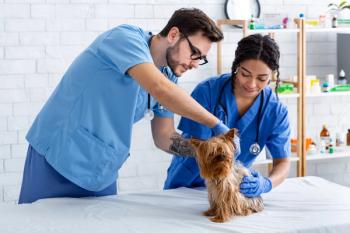
How safe are your vaccine procedures?
Many critical aspects of vaccination-from storage and handling to administration and patient safety-are in your hands.
Vaccines have played a large role in enabling people and animals to live longer and healthier lives. In our lifetimes, human diseases such as polio have been nearly eradicated. It is hoped that with the same dedication and vigilance, the veterinary community can help eliminate animal diseases such as parvovirus and panleukopenia. Vaccination protocols are the foundation of veterinary wellness. Proper transport, storage, handling, and administration of vaccines are essential, and each person on the veterinary healthcare team plays a role in these important measures (see "
Why are these measures so critical? Veterinary medicine uses multiple types of vaccines, each with its own sensitivities. Modified-live virus vaccines are particularly heat-sensitive, while killed vaccines are usually much more tolerant of variations in storage and handling, but proper care is still a necessity. Adjuvants, added to many vaccines to improve the immune response, make vaccines more susceptible to freezing. Much of the veterinary vaccine knowledge is borrowed from human research, and the stability of a human vaccine varies greatly based on the pathogen, strain, formulation, manufacturer, and conditions. Cold chain is a term used in human medicine to stress the importance of stable transportation, storage, and handling, and administration of vaccines. Here are some proper cold-chain management practices to follow when working with veterinary vaccines.
Transportation
When a vaccine shipment arrives at the clinic, open and inspect it immediately for any obvious abnormalities, such as discoloration or particulate formation. An insulated cooler with cold packs is ideal for vaccine transport, whether from the manufacturer to your practice or in a mobile veterinary setting. The vaccine should be insulated to prevent direct contact between the vials or trays and the cold packs. Mobile practices should also include a thermometer to monitor temperature during transportation. To further reduce temperature fluctuations, place the cooler in the vehicle and not outside the passenger compartment (e.g., trunk or truck bed). After unpacking the shipment or upon return to the central clinic for a mobile unit, place all vaccines in the refrigerator for appropriate storage.
Storage
Be sure to read the manufacturer recommendations for each vaccine since there may be specific storage requirements, exposure guidelines, or handling information. General recommendations for vaccine storage include protecting the vaccine from ultraviolet light and maintaining it at a stable temperature between 35 F (2 C) and 46 F (8 C). Be sure to rotate stock to avoid the presence of expired vaccine. If there is ever a concern as to the quality of a vaccine for any reason, contact the manufacturer before deciding to discard the product.
Refrigerator temperature is most stable in the center of the refrigerator, so it's the ideal place for vaccine storage. Typically, warmer temperatures are found toward the front door and colder temperatures in the back; avoid these areas for vaccine storage. Keep a quality thermometer in the refrigerator, and log the temperature twice a day. Because of poor temperature control, dorm-size refrigerators are not recommended. Frequent opening and closing of the vaccine refrigerator contributes to unnecessary temperature fluctuations. This is an additional reason to enforce the Occupational Safety and Health Administration (OSHA) policy restricting the presence of food and drink in these refrigerators. Storing water jugs in the refrigerator will help maintain a stable temperature on a daily basis and be beneficial during a power outage. Unstable storage temperatures have been shown to reduce vaccine efficacy and cause an increased rate of vaccine failures and adverse reactions.
Handling
When reconstituting lyophilized (freeze-dried) vaccines, use only the diluent provided. The diluent may contain stabilizers, bactericides, chemicals, or buffers to ensure the correct pH balance of the product. The diluent itself does not usually require refrigeration, but it is often convenient to store it alongside the vaccine. During reconstitution, be sure that the dry powder has completely dissolved. Do not reconstitute the vaccine or draw it up until needed. The reconstituted vaccine may be sensitive to temperature changes, and the risk of bacterial contamination and overgrowth becomes a concern if the syringe has been at room temperature for an extended period. The American Association of Feline Practitioners recommends vaccine use within 30 minutes of reconstitution.
Always use a new needle and syringe and aseptic technique when reconstituting or drawing up vaccines. If your practice is in the habit of saving syringes, be aware that some chemicals used in the resterilization process have been identified as possible causes of vaccine failures and adverse reactions. Multidose vaccine vials are at increased risk for contamination, so extra care must be taken when drawing doses. Also, remember to avoid mixing products within the same syringe and to prepare a separate administration site for each vaccine to avoid cross-contamination and potential adverse reactions. Keep in mind that many vaccines may appear similar, and if the syringe is not labeled appropriately or is administered in an inefficient manner, mistakes can be made. Many single-use vaccines have peel-off labels that should be attached to the syringe to facilitate identification for proper use in the patient.
Although vaccination of the veterinary patient may seem routine, it is actually a multifaceted process. From proper handling and administration of vaccines to an appropriate understanding of immunology, each member of the veterinary healthcare team has a part in establishing and managing optimal healthcare programs for each patient (see "
Liza W. Rudolph, LVT, CVT, is the Chair of the Academy of Veterinary Technicians in Clinical Practice. She is currently employed with the Internal Medicine service at the Veterinary Specialty Center of Delaware in New Castle, Del.
Newsletter
From exam room tips to practice management insights, get trusted veterinary news delivered straight to your inbox—subscribe to dvm360.






